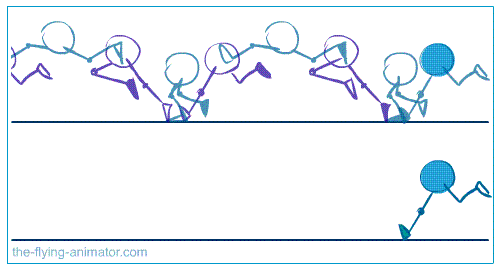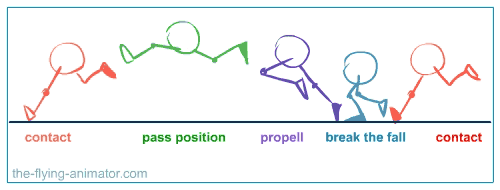How to Animate a Run Cycle
A run cycle has the same basic animation principles as a walk cycle - but with a lot more force.
Instead of just propelling our mass forward, we need to push it entirely off the ground.
These are the basic key frames for one step of a running cycle:

 Keyframes for a running cycle
Keyframes for a running cycleThis illustration shows only one step - remember to animate the second leg!
This is running at 14 frames per step (one leg), at 24 fps.
- It's easiest to start with the contact keyframe (red) where the heel hits the ground.
- Then the rest of the foot comes down - with the full weight of the body coming down on the leg. (The foot doesn't slide forward - Please note that the keys above have been spread out for better viewing.)
- Use this momentum, and propel the mass forward and up. This keyframe looks best when the pushing leg is stretched to the extreme and the toe JUST still touches the ground. It's the contact that makes it a powerful keyframe. It's a push, not a floating drawing.
- Now the body flies through the air:
How long?
How far?
How high?
The answers all depend on the character you're animating.
The TIMING for the whole cycle also depends on this part of the animation. The "air-time" part is the longest part of the cycle. In the example above, the run takes 6 frames on the ground and 8 frames in the air (not touching the ground at all for 8 whole frames). - Coming back to the ground, the heel leads, the leg stretched out to extreme before the weight falls on it.
- The arms will swing opposite to the legs, balancing out the body weight.
Drawing Extreme Keyframes
Don't be afraid!
Stretch and squash your character to get a convincing sense of force in your run.
To quote Disney's Master Animators Frank Thomas and Ollie Johnston:
"If you think you went far enough - Go Further!"
Stretch some more.
Squash harder.
Get the energy into the spring!
It works very well with only one in-between between the squash and stretch.
And it's really snappy without any in-betweens at all!
Timing a run cycle
A running cycle can be as short as 2 frames per leg - one up one down, like Pinocchio on the Japanese TV series.
It can also be the long dreamy strides for a long legged athlete.
Spacing is crucial:
Ease out - slow down on the way up
Ease in - gather speed on the way back down
This is a must.
Even if you do nothing else - get the spacing right.
The run cycle will magically look good even if everything else is off.
Have fun now,
'Gotta run!
Walk on the wild side: Animate a walking cycle from the side-view
Walking forward: Click here to see how a walk cycle looks from the front
In this Section
walk cycle
walk cycle front
run cycle
You might also like
Recording soundtrack - Master Class
